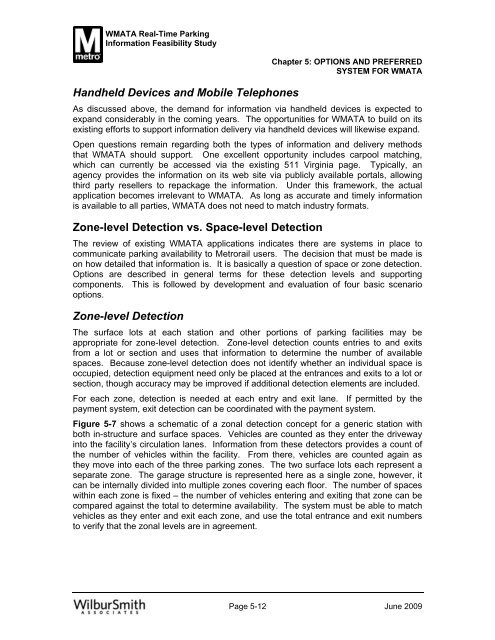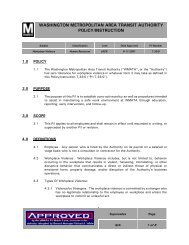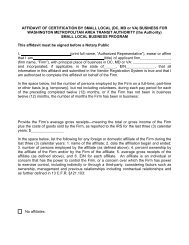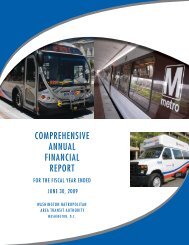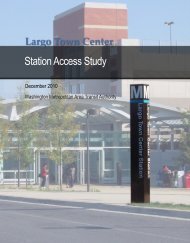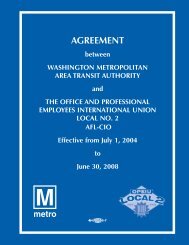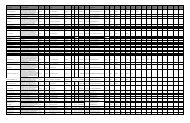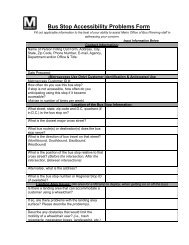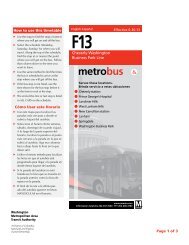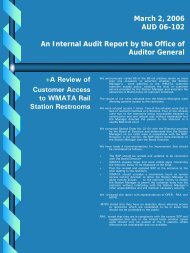feasibility study of real time parking information at ... - WMATA.com
feasibility study of real time parking information at ... - WMATA.com
feasibility study of real time parking information at ... - WMATA.com
You also want an ePaper? Increase the reach of your titles
YUMPU automatically turns print PDFs into web optimized ePapers that Google loves.
<strong>WMATA</strong> Real-Time Parking<br />
Inform<strong>at</strong>ion Feasibility Study<br />
Handheld Devices and Mobile Telephones<br />
Chapter 5: OPTIONS AND PREFERRED<br />
SYSTEM FOR <strong>WMATA</strong><br />
As discussed above, the demand for <strong>inform<strong>at</strong>ion</strong> via handheld devices is expected to<br />
expand considerably in the <strong>com</strong>ing years. The opportunities for <strong>WMATA</strong> to build on its<br />
existing efforts to support <strong>inform<strong>at</strong>ion</strong> delivery via handheld devices will likewise expand.<br />
Open questions remain regarding both the types <strong>of</strong> <strong>inform<strong>at</strong>ion</strong> and delivery methods<br />
th<strong>at</strong> <strong>WMATA</strong> should support. One excellent opportunity includes carpool m<strong>at</strong>ching,<br />
which can currently be accessed via the existing 511 Virginia page. Typically, an<br />
agency provides the <strong>inform<strong>at</strong>ion</strong> on its web site via publicly available portals, allowing<br />
third party resellers to repackage the <strong>inform<strong>at</strong>ion</strong>. Under this framework, the actual<br />
applic<strong>at</strong>ion be<strong>com</strong>es irrelevant to <strong>WMATA</strong>. As long as accur<strong>at</strong>e and <strong>time</strong>ly <strong>inform<strong>at</strong>ion</strong><br />
is available to all parties, <strong>WMATA</strong> does not need to m<strong>at</strong>ch industry form<strong>at</strong>s.<br />
Zone-level Detection vs. Space-level Detection<br />
The review <strong>of</strong> existing <strong>WMATA</strong> applic<strong>at</strong>ions indic<strong>at</strong>es there are systems in place to<br />
<strong>com</strong>munic<strong>at</strong>e <strong>parking</strong> availability to Metrorail users. The decision th<strong>at</strong> must be made is<br />
on how detailed th<strong>at</strong> <strong>inform<strong>at</strong>ion</strong> is. It is basically a question <strong>of</strong> space or zone detection.<br />
Options are described in general terms for these detection levels and supporting<br />
<strong>com</strong>ponents. This is followed by development and evalu<strong>at</strong>ion <strong>of</strong> four basic scenario<br />
options.<br />
Zone-level Detection<br />
The surface lots <strong>at</strong> each st<strong>at</strong>ion and other portions <strong>of</strong> <strong>parking</strong> facilities may be<br />
appropri<strong>at</strong>e for zone-level detection. Zone-level detection counts entries to and exits<br />
from a lot or section and uses th<strong>at</strong> <strong>inform<strong>at</strong>ion</strong> to determine the number <strong>of</strong> available<br />
spaces. Because zone-level detection does not identify whether an individual space is<br />
occupied, detection equipment need only be placed <strong>at</strong> the entrances and exits to a lot or<br />
section, though accuracy may be improved if additional detection elements are included.<br />
For each zone, detection is needed <strong>at</strong> each entry and exit lane. If permitted by the<br />
payment system, exit detection can be coordin<strong>at</strong>ed with the payment system.<br />
Figure 5-7 shows a schem<strong>at</strong>ic <strong>of</strong> a zonal detection concept for a generic st<strong>at</strong>ion with<br />
both in-structure and surface spaces. Vehicles are counted as they enter the driveway<br />
into the facility’s circul<strong>at</strong>ion lanes. Inform<strong>at</strong>ion from these detectors provides a count <strong>of</strong><br />
the number <strong>of</strong> vehicles within the facility. From there, vehicles are counted again as<br />
they move into each <strong>of</strong> the three <strong>parking</strong> zones. The two surface lots each represent a<br />
separ<strong>at</strong>e zone. The garage structure is represented here as a single zone, however, it<br />
can be internally divided into multiple zones covering each floor. The number <strong>of</strong> spaces<br />
within each zone is fixed – the number <strong>of</strong> vehicles entering and exiting th<strong>at</strong> zone can be<br />
<strong>com</strong>pared against the total to determine availability. The system must be able to m<strong>at</strong>ch<br />
vehicles as they enter and exit each zone, and use the total entrance and exit numbers<br />
to verify th<strong>at</strong> the zonal levels are in agreement.<br />
Page 5-12 June 2009


